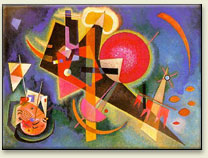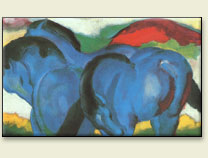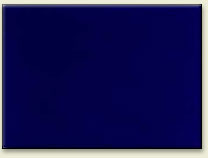Wassily Kandinsky, In the Blue, 1925
Franz Marc, The Little Blue Horses, 1911
Yves Klein, Monochrom Blue (IKB 181), 1956
Wassily Kandinsky, Franz Mark and Der Blaue Reiter
Russian painter W. Kandinsky wrote in his famous book "On the Spiritual in Art" in 1910:
"The inclination of blue to depth is so strong that its inner appeal is stronger when its shade is deeper. The darker the shade of the blue color, the stronger is its call into the Infinite, the stronger is the yearning for Purity and finally for the Transcendental."
Wassily Kandinsky and Franz Marc published an Almanac in 1912 named "Blauer Reiter" (Blue Rider). The Publication was preceded by two expositions of the famous group of artists based in Munich with the same name. Both painters loved the color blue and horses. Franz Marc’s blue horses became quite famous. In the Romantic times the Blue Flower mirrored Man himself as a part of Nature. Franz Marc reached far beyond this concept in his Blue Horses:
"We shall not paint the forest or the horse in the way we like them or according to their appearance to us, we shall paint them as they really are, how the forest or the horse perceive themselves, according to their absolute nature thriving behind the visible facade ... We have to learn from now on to relate the animals and plants to ourselves and to depict this relationship in Art." (Marc 1912/13 in Partsch 1993)
Marc returned in his Blue Horses and other paintings of animals the soul to the creatures, the same soul they possessed in the neolithic Cave Paintings. In his "Dreaming Horse (1913)" he alludes again to the dreamlike quality of blue color. Marc’ lets horses to have yearnings, he had a strong inner relation to animals, they awoke the goodness in him.
(main blues page) - Azurite - cobalt blue - Egyptian blue - Indigo - Prussian blue - smalt - Ultramarine - Cerulean Blue



